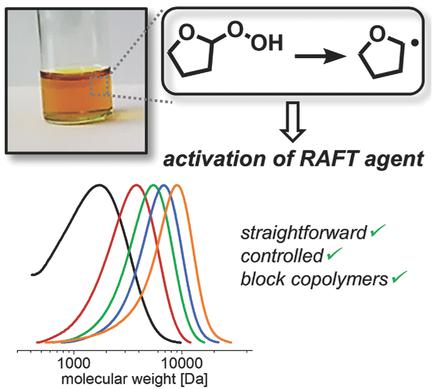当前位置:
X-MOL 学术
›
Macromol. Rapid Commun.
›
论文详情
Our official English website, www.x-mol.net, welcomes your feedback! (Note: you will need to create a separate account there.)
Hydroperoxide Traces in Common Cyclic Ethers as Initiators for Controlled RAFT Polymerizations
Macromolecular Rapid Communications ( IF 4.6 ) Pub Date : 2018-01-15 , DOI: 10.1002/marc.201700683 Steffen Eggers 1 , Volker Abetz 1, 2
Macromolecular Rapid Communications ( IF 4.6 ) Pub Date : 2018-01-15 , DOI: 10.1002/marc.201700683 Steffen Eggers 1 , Volker Abetz 1, 2
Affiliation

|
Herein, a reversible addition–fragmentation chain transfer (RAFT) polymerization is introduced for reactive monomers like N‐acryloylpyrrolidine or N,N‐dimethylacrylamide working without a conventional radical initiator. As a very straightforward proof of principle, the method takes advantage of the usually inconvenient radical‐generating hydroperoxide contaminations in cyclic ethers like tetrahydrofuran or 1,4‐dioxane, which are very common solvents in polymer sciences. The polymerizations are surprisingly well controlled and the polymers can be extended with a second block, indicating their high livingness. “Solvent‐initiated” RAFT polymerizations hence prove to be a feasible access to tailored materials with minimal experimental effort and standard laboratory equipment, only requiring the following ingredients: hydroperoxide‐contaminated solvent, monomer, and RAFT agent. In other respects, however, the potential coinitiating ability of the used solvent is to be considered when investigating the kinetics of RAFT polymerizations or aiming for the synthesis of high‐livingness polymers, e.g., multiblock copolymers.
中文翻译:

常见环状醚中痕量的氢过氧化物作为引发RAFT聚合反应的引发剂
在此,针对反应性单体(如N-丙烯酰基吡咯烷或N,N)引入了可逆加成-断裂链转移(RAFT)聚合‐二甲基丙烯酰胺无需使用常规自由基引发剂即可工作。作为原理的直接证明,该方法利用了在环状醚(如四氢呋喃或1,4-二恶烷)中通常不方便的自由基产生的氢过氧化物污染,这在聚合物科学中是非常常见的溶剂。令人惊奇的是,聚合反应得到了很好的控制,并且聚合物可以通过第二个嵌段进行扩展,表明它们的高活性。因此,“溶剂引发的” RAFT聚合被证明是用最少的实验工作和标准的实验室设备即可获得量身定制的材料的可行途径,只需要以下成分:被过氧化氢污染的溶剂,单体和RAFT剂。但是,在其他方面,
更新日期:2018-01-15
中文翻译:

常见环状醚中痕量的氢过氧化物作为引发RAFT聚合反应的引发剂
在此,针对反应性单体(如N-丙烯酰基吡咯烷或N,N)引入了可逆加成-断裂链转移(RAFT)聚合‐二甲基丙烯酰胺无需使用常规自由基引发剂即可工作。作为原理的直接证明,该方法利用了在环状醚(如四氢呋喃或1,4-二恶烷)中通常不方便的自由基产生的氢过氧化物污染,这在聚合物科学中是非常常见的溶剂。令人惊奇的是,聚合反应得到了很好的控制,并且聚合物可以通过第二个嵌段进行扩展,表明它们的高活性。因此,“溶剂引发的” RAFT聚合被证明是用最少的实验工作和标准的实验室设备即可获得量身定制的材料的可行途径,只需要以下成分:被过氧化氢污染的溶剂,单体和RAFT剂。但是,在其他方面,


























 京公网安备 11010802027423号
京公网安备 11010802027423号